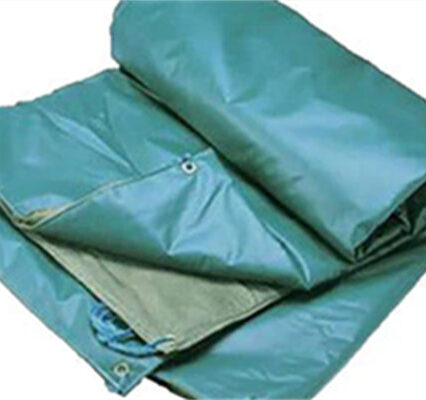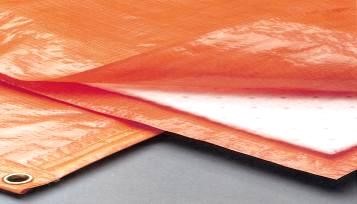
In the realm of outdoor gear and construction materials, the term lona aislante goes far beyond the ordinary blue or silver tarps we associate with temporary shelters or cargo covers. Today, insulated construction tarps represent a significant leap forward in functionality and versatility. They cater to a wide range of needs—from extreme weather protection in camping to energy-efficient practices in construction sites. Let’s explore what insulated tarps are, their unique features, and why they should be your go-to choice for outdoor projects.

I. Definición y fundamentos
Insulating tarps are high-performance, multi-layered tarpaulin sheets designed to provide enhanced insulation. Unlike traditional tarps made solely from polyethylene or PVC, an insulated tarpaulin incorporates additional layers of insulating material such as foam, bubble wrap, or reflective film. This innovative construction not only improves durability but also enhances their ability to retain heat, block cold, and regulate temperature fluctuations—making them excellent insulation tarps for both outdoor and industrial use.
II. Principales características y ventajas
1. Regulación de la temperatura:
An insulated construction tarp is ideal for winter construction sites, cold-weather camping, or as an insulated tarp for tent setups. It helps regulate temperature and retain warmth effectively.
2. Resistencia a la humedad:
Many insulated tarps are waterproof, ensuring your workspace or camping gear stays dry even in harsh conditions.
3. Durabilidad:
Heavy-duty materials and reinforced seams make insulated tarpaulins capable of withstanding wind, snow, or strong UV rays.
4. Ligero y portátil:
Despite their advanced build, insulated tarps for camping remain lightweight and easy to carry, perfect for hikers, campers, or contractors.
5. Versatilidad:
Whether used as an insulating tarp for livestock barns, a temporary roof cover, or even as soundproofing in construction, their applications are diverse.
III. Aplicaciones en todos los sectores
1. Ocio al aire libre:
Campers and hikers use insulated tarps for camping to create warm, dry shelters, protect equipment, or build makeshift kitchens in cold weather.
2. Construcción y renovación:
Builders rely on insulated construction tarps to shield unfinished structures, protect against frost, and provide temporary insulation during roofing or siding projects.
3. Agricultura:
Farmers use insulated tarpaulins to regulate greenhouse temperatures, protect livestock barns, and prevent frost damage to crops.
4. Respuesta de emergencia:
Relief teams deploy insulated tarps as shelters, storage units, or medical stations in disaster areas.
5. Gestión de eventos:
Event planners turn to insulation tarps for controlled environments at outdoor concerts, festivals, and exhibitions.
IV. Elegir la lona aislante adecuada
When buying an insulated tarp, consider:
1. Composición del material:
Busque lonas con materiales aislantes de alta calidad que se adapten a sus necesidades específicas (por ejemplo, núcleo de espuma para un aislamiento máximo, película reflectante para retener el calor).
2. Tamaño y forma:
From small insulated tarps for camping to large insulated construction tarps, match the tarp to your project.
3. Durabilidad y peso:
Equilibra la necesidad de durabilidad con la de portabilidad. Las lonas más pesadas pueden ofrecer un mejor aislamiento, pero pueden ser más difíciles de transportar.
4. Resistencia a la intemperie:
Elige una lona que pueda soportar las condiciones meteorológicas previstas, incluida la impermeabilidad, la resistencia a los rayos UV y la resistencia al viento.
5. Facilidad de instalación y almacenamiento:
Busque lonas con ojales o lazos reforzados para facilitar el montaje y opciones de almacenamiento compacto para el transporte.
V. Mantenimiento y almacenamiento de lonas aislantes
Un mantenimiento y almacenamiento adecuados pueden prolongar la vida útil de tu lona aislante. He aquí algunos consejos:
1. Limpiar regularmente:
Mild soap and water are enough to clean your insulating tarp.
2. Inspeccione si hay daños:
Compruebe periódicamente si hay roturas, pinchazos o desgaste, y repárelo si es necesario para evitar daños mayores.
3. Almacenar correctamente:
Store your insulated tarps in a cool, dry place, away from direct sunlight and extreme temperatures. Folding or rolling them up tightly can help prevent creases and wrinkles.
4. Evite los objetos pesados:
Evita apilar objetos pesados sobre la lona, ya que esto puede comprimir las capas aislantes y reducir su eficacia.
Conclusión
From insulated construction tarps on job sites to insulated tarps for camping adventures, these multi-layered covers deliver unmatched durability, weather protection, and temperature control. Whether you need an insulated tarp for tent use, agricultural storage, or industrial applications, choosing the right insulated tarpaulin ensures reliability and efficiency.
Next time you face harsh outdoor conditions, consider the benefits of a high-quality insulated tarp—your ultimate solution for warmth, durability, and versatility.
